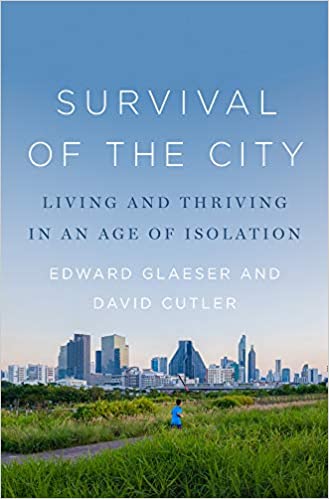You have /5 articles left.
Sign up for a free account or log in.
 Survival of the City: Living and Thriving in an Age of Isolation by Edward L. Glaeser and David Cutler
Survival of the City: Living and Thriving in an Age of Isolation by Edward L. Glaeser and David Cutler
Published in September 2021
There is no good place to live through a global pandemic. However, perhaps the least-worst place to live during these last 18 months has been in a small college town.
Way back in pre-COVID times, I wrote about some of the advantages of living and working in my own small college town. (In a failed but I think prescient attempt to persuade Amazon to locate HQ2 in Hanover, N.H. -- population 11,473.)
Before the pandemic, the accepted wisdom was that cities are where it’s at. Peak pro-urbanist thinking may have arrived with the publication of Edward Glaeser's 2011 Triumph of the City.
Those of us lucky enough to live in a small college town know how good we have it. The rest of the world seemed to be beating a path to a short list of superstar cities.
In the years to come, will the pull of the city diminish?
Will all those creative-class professionals who once dreamed of living in Boston, Austin, San Francisco, New York City, Atlanta and Charlotte aim instead for Madison, Ann Arbor, Bozeman, Oxford and Morgantown?
Glaeser and co-author Cutler’s new book, Survival of the City, is well timed to address the question of the future of the post-pandemic city.
For Glaeser and Cutler (both highly respected and influential Harvard economists), the pre-eminent role of cities as the prime engines of creative and economic progress will remain intact.
Survival of the City provides a well-crafted history lesson concerning the resilience of urban centers in the face of past plagues. There is every reason that cities should come back stronger than ever in the years to come. It would be a mistake to bet against the growth and dynamism of large cities. However, they argue that unless a range of smart policies are followed, the pandemic will exacerbate and deepen existing structural inequalities.
These policies include a willingness to rescind local regulations that make it difficult to build dense housing in many urban areas, the development of one-stop new business permitting offices, and a national effort (the Apollo program) to experiment on improving educational outcomes.
On the international level, Glaeser and Cutler call for a NATO for global public health -- a cross-national association with the funding, expertise and mandate to invest in the public health infrastructure of developing countries while creating incentives and sanctions powerful enough to drive national policies and investments.
Will cities empty of workers as companies move to permanent telecommuting? Glaeser and Cutler are skeptical that remote work will completely supplant face-to-face jobs. The pandemic, however, may open up some space in cities for smaller and scrappier companies to get an urban real estate foothold, as more established firms (like banks) decide they need less office space for a more flexible workforce.
We need more books co-authored by moderate Republicans (Glaeser) and centrist Democrats (Cutler). Neither conservatives nor liberals can dismiss the ideas in Survival of the City as ideologically driven.
Conservatives can be just as concerned about stratification, police violence and poor population health as liberals. Democrats may find the policy recommendations put forward by Republicans like Glaeser for urban redesign, education reform and public health investments both informative and sensible.
Survival of the City lays out a compelling vision for reasonable, doable and affordable policy changes that would improve the quality of life in cities and benefit everyone across the nation.
While the book contains some exemplars of these reforms in action -- drawn mainly from the authors’ hometown of Boston -- there are still too few examples of effective governance from other U.S. cities. (New Zealand comes across as the anti-U.S. in terms of good governance.) More time spent in the book analyzing the post-pandemic prospects of lower-cost cities would have been appreciated.
The advantages of the approach that Glaeser and Cutler take in not bogging down on too many detailed policy details or in-depth case studies is that the book is full of big ideas, accompanied by some fascinating stories (like how gentrification plays out in L.A.). This is an important book of ideas, history and policy recommendations, a book that should be read and discussed by anyone concerned with the future of cities.
Cities will survive the pandemic. They will likely even thrive in the years to come. But I’d be remiss if I did not mention that the best place to live, work and even retire is a small college town.
What are you reading?








